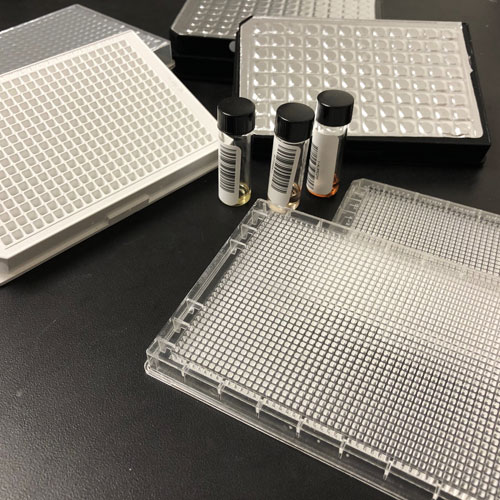High Throughput Screening
The High Throughput Screening Shared Resource (HTSSR) is dedicated to helping Simmons members initiate and execute research efforts dedicated to turning new insights in cancer biology into preclinical drug and target discovery initiatives. Screening projects typically have one or more translational goals: identification of new cancer targets via functional genomics or chemical screens, development of new therapeutics (small molecules), and/or identification of relevant therapeutic biomarkers to stratify patients in the clinical setting.
Services
- Assay Development
Assay development and validation are critical and time-intensive activities of High Throughput Screening Shared Resource projects. Our scientists efficiently develop and optimize biochemical or cell-based assays spanning many measurement types including fluorescence, Alpha Screen, luminescence, absorbance, radiometric, mass spectrometric, and image-based readouts. In collaboration with each Simmons Cancer Center member, the HTSSR organizes relevant assays into a screening strategy for each project that will enable selection of compounds that align with project goals. - High Throughput Chemical Screens
For high throughput chemical screens, investigators have access to the UT Southwestern chemical library (393,702 drug-like compounds), which consists of 388,624 drug-like small molecules from commercial sources, 2,455 compounds from UTSW chemists, and 2,623 experimental and FDA approved drugs. Once all the assays for a project are optimized, a pilot screen of an 8,000-compound diversity subset is conducted to demonstrate robustness and utility of the assay. The diversity subset is made up of compounds that are chemically representative of 200,000 compounds in the larger library. For the pilot screen and large chemical screens, the HTSSR analyzes the primary data, repeats failed plates, uploads the final data set to our screening database, and delivers a report to the sponsoring Simmons Cancer Center member. Using historical screening data and relevant literature, HTSSR works with Simmons Cancer Center members to select compounds with desirable activity profiles for confirmation studies. SCCC members can gain access to the larger chemical library and an associated subsidy of 50% on screening consumables by submitting a short proposal to the HTSSR’s Internal Advisory Committee (IAC), which is made up of SCCC members with experience in chemical and functional genomics screening. - High Throughput Functional Genomics Screens
Functional genomics screens essentially take the same path as chemical screens: assay development and optimization, screening, analysis, summarization followed by hit selection, and validation. HTSSR maintains a human genome-wide siRNA library (~21,000 human genes, Horizon Biosciences, Inc.), an arrayed human CRISPR library (36,000 gRNA’s, 2 gRNA’s per gene, SigmaMillipore, Inc.) and the Brunello Pooled CRISPR library. After screening, project scientists use bioinformatics tools and expertise in cancer biology to prioritize genes for further characterization. The move to CRISPR screening provides a more effective gene knock out tool with fewer off-target effects than RNAi. - Advanced Support for Pre-clinical Drug Discovery
Following a typical chemical screen, the sponsoring SCCC member, the project team chemist(s), HTSSR Director, and the Director of the Pre-clinical Pharmacology Core (Noelle Williams, Ph.D.) review the structures of confirmed hits and select those with the greatest potential for further study and development. This multidisciplinary effort is an iterative process that involves design and synthesis of analogs of valued hits and assessing them for potency, selectivity, mechanism of action, ADME properties, and cellular activity. The goal is to create lead compounds with high efficacy in an animal model of cancer. With success in this proof-of-concept experiment, the SCCC member and the multi-discipline team can advance their lead(s) to late-stage, pre-clinical studies, and clinical trials. In the context of hit-to-lead optimization, HTSSR provides bioassay, chemoinformatics, data management, and computational chemistry support (structure-based drug design for medicinal chemists, site mapping and docking studies for hit compounds and potential target proteins in phenotypic screens, and virtual screening support for scaffold hopping and hit expansion).
Equipment and Technology
HTSSR maintains the following instruments necessary for high-throughput screening:
- Low volume liquid transfer in 96, 384, and 1536 well plates: one Biomek i7 instrument, a Span-8, and two Echo 655 acoustic droplet ejection (ADE) dispensers, each with an Access automation package
- Four multimode plate readers to quantitate luminescence, fluorescence, AlphaScreen, and absorbance 4 assays
- InCell Analyzer 6000, an automated microscope for high content, image-based screening that reads 96, 384, or 1536 well formats and supports live or fixed cell imaging in standard or confocal modes
- RapidFire mass spectroscopy reader to measure low MW analytes from biochemical and cell-based assays
- BioTek EL406 plate washer/dispenser
- Seven BioTek Microflo bulk liquid handlers
- Two Agilent PlateLoc plate sealers
- Two plate barcode printers
Monitored, cryogenic storage units house mammalian cell banks (over 150 cell lines spanning breast, lung, ovarian, gastric, and pancreatic cancers). A BioMicroLab XL100 handles compounds submitted by chemists for testing and incorporation into the library. This instrument transfers compounds from 1-dram vials to 2D barcoded tubes for storage, library plate creation, and cherry picking. Six -80°C and seven -20°C freezers are used for storage. Software and database platforms include a Laboratory Information Management System (LIMS, v6.1.4; Thermo Inc.) Genedata Screener for data analysis (v.20.0.3), Biovia’s Pipeline Pilot (v.2021) for data aggregation and summarization, Glide (v.2025-2), and MOE (v.2024.0601) for SBDD and docking studies, and Tibco’s Spotfire (v. 14.0.2) for data visualization.
Fees
Members receive a 20% subsidy on consumables costs for assay development and pilot screens and 50% on larger screens (with an upper limit of $12,500 for each screen), which provides an incentive to all members to take advantage of HTSSR. Charges to investigators include personnel time, instrument usage, reagents, consumables, and computational resources. The fee structure is tiered with external commercial and external academic users paying 3x and 2x the internal UTSW rate, respectively.
For additional information, including signing up for services, please visit the HTS Lab Site.
Leadership and Contact


